CCNA – Operations 1
Here you will find answers to Operations Questions (Part 1)
Question 1:
What are two reasons that a network administrator would use access lists? (Choose two.)
A. to control vty access into a router
B. to control broadcast traffic through a router
C. to filter traffic as it passes through a router
D. to filter traffic that originates from the router
E. to replace passwords as a line of defense against security incursions
Answers: A C
Question 2:
A single 802.11g access point has been configured and installed in the center of a square office. A few wireless users are experiencing slow performance and drops while most users are operating at peak efficiency. What are three likely causes of this problem? (Choose three.)
A. mismatched TKIP encryption
B. null SSID
C. cordless phones
D. mismatched SSID
E. metal file cabinets
F. antenna type or direction
Answers: C E F
Question 3:
Refer to the exhibit. How many broadcast domains exist in the exhibited topology?
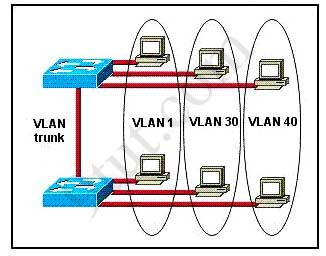
A. one
B. two
C. three
D. four
E. five
F. six
Answer: C
Question 4:
Which type of attack is characterized by a flood of packets that are requesting a TCP connection to a server?
A. denial of service
B. brute force
C. reconnaissance
D. Trojan horse
Answer: A
Question 5:
Refer to the exhibit.
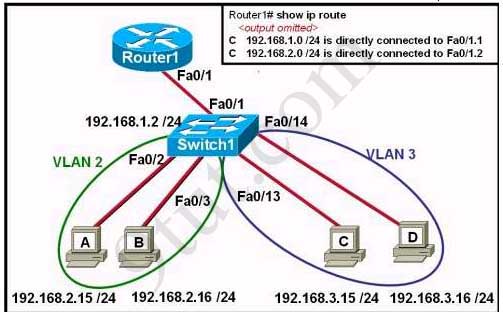
The network administrator has created a new VLAN on Switch1 and added host C and host D. The administrator has properly configured switch interfaces FastEthernet0/13 through FastEthernet0/24 to be members of the new VLAN. However, after the network administrator completed the configuration, host A could communicate with host B, but host A could not communicate with host C or host D. Which commands are required to resolve this problem?
A. Router(config)# interface fastethernet 0/1.3
Router(config-if)# encapsulation dot1q 3
Router(config-if)# ip address 192.168.3.1 255.255.255.0
B. Router(config)# router rip
Router(config-router)# network 192.168.1.0
Router(config-router)# network 192.168.2.0
Router(config-router)# network 192.168.3.0
C. Switch1# vlan database
Switch1(vlan)# vtp v2-mode
Switch1(vlan)# vtp domain cisco
Switch1(vlan)# vtp server
D. Switch1(config)# interface fastethernet 0/1
Switch1(config-if)# switchport mode trunk
Switch1(config-if)# switchport trunk encapsulation isl
Answer: A
Explanation:
Communication between host A and host B on the same VLAN does not need a router but communication between host A and host C (or host D) need a layer 3 device, in this case Router1, which is called a “router on a stick”. From the output of Router1, we notice that there is not any route to the new network 192.168.3.0/24 which host C and host D belong to. Therefore, we need to configure a subinterface for this network.
Question 6:
Refer to the exhibit. What is the most efficient summarization that R1 can use to advertise its networks to R2?
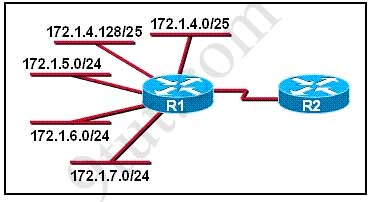
A. 172.1.0.0/22
B. 172.1.0.0/21
C. 172.1.4.0/22
D. 172.1.4.0/24
172.1.5.0/24
172.1.6.0/24
172.1.7.0/24
E. 172.1.4.0/25
172.1.4.128/25
172.1.5.0/24
172.1.6.0/24
172.1.7.0/24
Answer: C
Explanation:
Network 172.1.4.0/25 and network 172.1.4.128/25 can be grouped to a single network 172.1.4.0/24
Network 172.1.4.0/24 + Network 172.1.5.0/24 + Network 172.1.6.0/24 + Network 172.1.7.0/24 can be grouped to a single network 172.1.4.0/22 because we have all 4 subnetworks so we can move left 2 bits (22=4)
Question 7:
Which spread spectrum technology does the 802.11b standard define for operation?
A. IR
B. DSSS
C. FHSS
D. DSSS and FHSS
E. IR, FHSS, and DSSS
Answer: B
Question 8:
A network interface port has collision detection and carrier sensing enabled on a shared twisted pair network. From this statement, what is known about the network interface port?
A. This is a 10 Mb/s switch port.
B. This is a 100 Mb/s switch port.
C. This is an Ethernet port operating at half duplex.
D. This is an Ethernet port operating at full duplex.
E. This is a port on a network interface card in a PC.
Answer: C
Explanation:
Modern Ethernet networks built with switches and full-duplex connections no longer utilize CSMA/CD. CSMA/CD is only used in obsolete shared media Ethernet (which uses repeater or hub).
Question 9:
Refer to the topology and router configuration shown in the graphic. A host on the LAN is accessing an FTP server across the Internet. Which of the following addresses could appear as a source address for the packets forwarded by the router to the destination server?
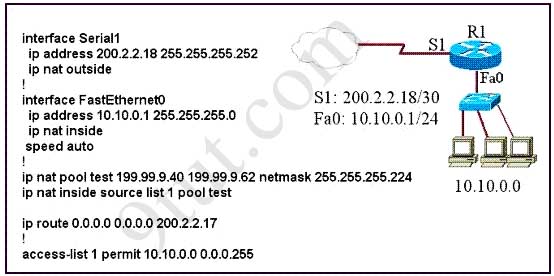
A. 10.10.0.1
B. 10.10.0.2
C. 199.99.9.33
D. 199.99.9.57
E. 200.2.2.17
F. 200.2.2.18
Answer: D
Question 10:
Which routing protocol by default uses bandwidth and delay as metrics?
A. RIP
B. BGP
C. OSPF
D. EIGRP
Answer: D
Question 11:
Refer to the exhibit. The networks connected to router R2 have been summarized as a 192.168.176.0/21 route and sent to R1. Which two packet destination addresses will R1 forward to R2? (Choose two)
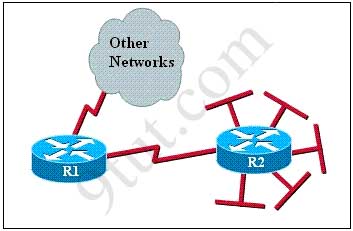
A. 192.168.194.160
B. 192.168.183.41
C. 192.168.159.2
D. 192.168.183.255
E. 192.168.179.4
F. 192.168.184.45
Answer: B E
Explanation:
From the subnet mask of /21, we can specify the network address and broadcast address of this subnetwork:
Increment: 8 of the third octet(/21 = 255.255.248.0 or 1111 1111.1111 1111. 1111 1000.0000 0000)
Network address: 192.168.176.0
Broadcast address: 192.168.183.255 (183 = 176 + 8 – 1)
Therefore all the destination addresses in this range will be forwarded to R2 -> B and E lie in this range and their packages will be forwarded to R2. Please notice that D is an incorrect answer because it is a broadcast address and R1 will drop its packages.
Question 12:
Refer to the exhibit. Which switch provides the spanning-tree designated port role for the network segment that services the printers?
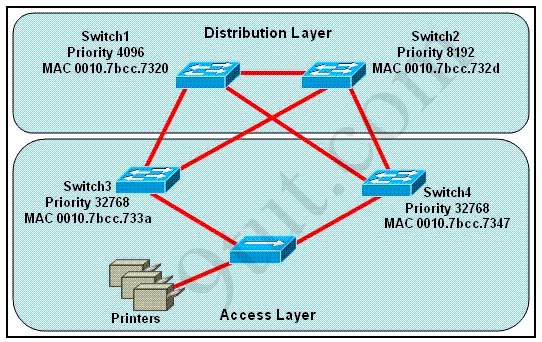
A. Switch1
B. Switch2
C. Switch3
D. Switch4
Answer: C



please i dont understand que 8 i thought csma/cd operate in full duplex mode and csma/ca operate in half duplex mode
@landon
csma/cd is used on wired shared networks (will work at half-duplex)
csma/ca is used on wireless networks (something like the wired equivalent)
chooran Chatni !
Regarding Question 3 ,
Isn’t Trunk should be a 4th broadcast domain ? as it pass all Vlans plus defalut Vlan 1
Hey Nathan,Been relaly relaly busy with my MSc. Just had a break last week after finishing all my assignments. So started to do some changes last week. It’s all better now ;)
thanks 9tut!=D
Q2 and 7 were in my exam today…
Hi all, I am taking CCNA 640-802 exam first time on 30/05/2012. Could anyone please send me latest dumps which are valid for UK? My e-mail address is puneet_gill84@yahoo.co.uk. Many thanks.
I PASSED CCNA EXAM TODAY THANKS TO ALL MIGHTY ALLAH
960/1000
Q1
I think option D is Better Than C, ACL every consider inbound or outbound traffic when applied, Being the filtering work near the destiny device or source device (traffic that originates from the router), option D.
Waiting Opinion.
Full-Duplex Operation 10/100/1000
Everything you’ve read so far dealt with half-duplex operation (CSMA/CD, back-off timers, and so on). Full-duplex mode allows stations to transmit and receive data simultaneously. This makes for more efficient use of the available bandwidth by allowing open access to the medium. Conversely, this mode of operation can function only with Ethernet switching hubs or via Ethernet cross-over cables between interfaces capable of full-duplex Ethernet. Full-duplex mode expects links to be point-to-point links. There are also no collisions in full-duplex mode, so CSMA/CD is not needed.
I passed my ccna exam today Praise be to God! Thank you Jesus! and thanks to 9TUT for the tutorials and explanations, great site and thanks to xallax for your explanations to questions and thanks to http://www.examcollection.com for the dumps. Pls guys lets donate and help to keep this site up!
48 ques for exams including 3 simulation, I had EIGRP, Acesslist2 and VTP. Make sure the practice the simulation, use packet tracer or gns3. Best wishes to all!
koi hai jo mujhy fees k liye paise dai sake
Thanks a lot 9tut and Colliso. Just gave my CCNA exam and cleared with 894/1000.
Just study 9tut and Collisio dumps.
@xallax and 9tut
I believe option F for Q9 is correct ans
@DNT:
Q9
Because of the command “ip nat pool test 199.99.9.40 199.99.9.62 netmask 255.255.255.224″, R1 will use IP addresses in this range 199.99.9.40 -> 199.99.9.62 to replace the source addresses in the local VLAN before sending out to the Internet. R1 will not use the source address of S1 interface.
I have a one question please resolve it guys…
The output is from a router in a large enterprise. From the output, determine the role of the router.
Router A# show ip route
Codes: C – Connected, S – Static, I – IGRP, M – mobile, B – BGP
.
.
.
.
.
Gate of last resort is 0.0.0.0 to network 0.0.0.0
172.16.0.0/24 is subnetted, 1 subnets
C 172.16.1.0 is directly connected, Ethernet0/1
10.0.0.0/30 is subnetted, 1 subnets
C 10.255.255.255.200 is directly connected, Serial0/0
S* 0.0.0.0/0 is directly connected, Serial 0/0
RouterA#
(A) A Core Router
(B) The HQ Internet gateway router
(C) The WAN router at the central site
(D) Remote stub router at a remote site.
Question 12:
Refer to the exhibit. Which switch provides the spanning-tree designated port role for the network segment that services the printers?
at the end of the explanantion
(Please notice that Switch 1 will become the root bridge because of its lowest priority, not Switch 3)
what is really the answer Sw1 or Sw3
hi, q9 y is soure adress used from the pool? and not S1? pls
How dose a DHCP server dynamically assign IP address to host?
A. Addresses are allocated after a negotiation between the server and the host to determine the length of the agreement.
B. Addresses are assigned for a fixed period of time. At the end of period, a new quest for an address must be made, and another address is then assigned.
C. Addresses are leased to host. A host will usually keep the same address by periodically contacting the DHCP sever to renew the lease.
D. Addresses are permanently assigned so that the host uses the same address at all times.
please explain C. thanks guys.
can anyone explain the question no 6. because the subnet 25, how it changed to 24.
Hi Jack! As they’re networks it’s better to visualize them.
/25 =>255.255.255.128
Block size is 256-128=128
172.1.4.0 / 25 -> network 172.1.4.0, host 172.1.4.1 – 172.1.4.126
172.1.4.128 / 25 -> network 172.1.4.128, host 172.1.4.129 – 172.1.4.254
They’re combined to network 172.1.4.0, host 172.1.4.0 – 172.1.4.254, next network 172.1.5.0
Block size is 256, so mask is /24 > 255.255.255.0
Oops typo, I mean host 172.1.4.1 – 172.1.4.254
I wish there’s edit option for the posts.
please mail me the 64 bit crack file for virtual cert exam software……..am preparing for CCNA……….i need it please………or else give me a valid link to download……….
vipin.heat@gmail.com
vipin.heat@yahoo.com
Q 12 was at my exam at 12 aug
Q9 I think that F would be the answer in case we had pat running not nat with a nat pool that is exist foe using public address to connect the internet
I did it!!..907..q2 and 6 on exam…study concepts…good luck to all..
Answer for Q12 is correct, but explanation seems incorrect.
To determine the designated port on a network segment, we should first see which switch has the lowest cost to root bridge. In the event of a tie, only then will the lowest BID be used.
http://www.omnisecu.com/cisco-certified-network-associate-ccna/how-spanning-tree-protocol-stp-select-designated-port.htm
For this qn, the path cost is ambiguous because the port types are not specified. But if you assume all links are same speed, then Switch 3 has the lowest cost path to root bridge (hence the answer).
Can any expert verify my point?
@ 9tut
dnt u think the ans should be “D.four” as a switch as a whole also contribute to broadcast domain ie. the trunk, the two switches as 1 broadcast domain & the three vlans as three different broadcast domains………so total 4 broadcast domains……………
plz help…..i hv my xm in few days……….dnt want to fail coz of silly mistakes……tnx
@AnkushK: The trunk is not considered a separate broadcast domain. It is just the link where data of all VLANs can go through.
Does Microsegmentation decreases or increase the number of collisions on the network? Why?
Q12
Can someone pls post which interfaces in the diagram will be DP and BLK ports for all the switches
Thanks
not very clear with q11. any clue guys
thanks.
in q8. if the switch uses full duplex it doesn’t utilizes the csma/cd standard while if it uses half-duplex it uses the csma/cd standard am i right? what standard does full duplex use is it csma/ca? can someone clarifies this? tnx a lot
guys explain in details bout Q 9…. thought the source address was 200 network
I HAVE A DOUBT… CAN ANY PASSED ENGINEER PLEASE ANSWER IT ?
IN THE CCNA EXAM, CAN WE SKIP ANY UNKNOWN ANSWER ? OR DO WE HAVE TO ANSWER ALL FROM 1 TO 50 QUESTIONS CONTINUOSLY WITHOUT SKIP ?
THANKS
Yes, we can skip. But, as there is no negative marking, it is wise to answer it anyway. Who knows! you may get it right!!!!
Hi all
Anybody can tell me, fill-in-the blank is there in a CCNA exam ? my exam is Nov 14 2012.
PLEASE tell me?
Thanks
Hey every body i had exam icnd2 I passed barely
Q12 was in exam I had no sim question
@ Any One, if you plan on passing the exam, due not skip over anything.
Unlike a lot of dance crazes, The Twist had lasting power. In 1961, at the peak of The Twist craze, the house band, Joey Dee and the Starliters, at New York legendary Peppermint Lounge came out with Twist. Meanwhile, Bill Haley The Comets recorded Twist and Twist, both of which contributed to The Twist dissemination throughout Latin America..
pandora bracelets http://www.pandoracastore.com/pandora-bracelets
@merit
original source IP is some IP of the host from network 10.10.0.0/24, translated by router using NAT to IP from configured range: 199.99.9.40 – 199.99.9.62, so it could be any IP from this range, answer is 199.99.9.57.
frnds pls help me to get through dis ques…..
according 2 d routing table, whr vll d router send a packet destined for 10.1.5.65 ?
N/W Intrfce Nxt-hop
10.1.1.0/24 e0 directly connctd
10.1.2.0/24 e1 ”
10.1.3.0/25 s0 ”
10.1.4.0/24 s1 ”
10.1.5.0/24 e0 10.1.1.2
10.1.5.64/28 e1 10.1.2.2
10.1.5.64/29 s0 10.1.3.3
10.1.5.64/27 s1 10.1.4.4
1) 10.1.1.2
2) 10.1.2.2
3) 10.1.3.3
4) 10.1.4.4
Ashu answer is 10.1.3.3 because of the Longest Prefix rule. 10.1.5.65 is not on the network so it is sent through the Serial Interfaces to the Outside Network. However the question wants to know which Serial Interface it will use.
Among the choices: /29 or /27 which are serial interfaces it will send to the higher “/” number in this case it is /29 so you would choose 10.1.5.64 /29 over the other.
@ anonymous….thnx buddy 4 d info.
I don’t understand q 9. Please explained
Look at the NAT Pool it goes from 199.99.9.40 199.99.9.62. Think of it like this:
199.99.9.40 through 199.99.9.62
40 + x = 62
40 +22 = 62
so any number between 40 and 62 (199.99.9.40 – 199.99.9.62) will work as a source address.
hi everyone, I have a question which is similar to question 12
have a look at the screenshot
http://i47.tinypic.com/mtw7xd.png
according to dumps I have correct is , WHY?? why is not switch3, maybe it’s just my bad understanding of the question.
I meant correct is C
ok guys false alarm about question 12, I think I’m just to tired of revising cisco haha
I didn’t have look closely at the exhibition